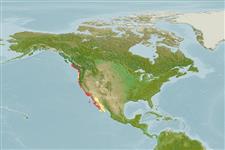Common names from other countries
>
Scombriformes (Mackerels) >
Stromateidae (Butterfishes)
Etymology: Peprilus: Greek, peprilos, paprax, certain fish from Tracia.
More on author: Ayres.
Environment: milieu / climate zone / depth range / distribution range
Écologie
marin benthopélagique; profondeur 9 - 91 m (Ref. 2850). Subtropical; 52°N - 23°N, 129°W - 109°W
Northeast Pacific: Queen Charlotte Sound in British Columbia, Canada to southern Baja California Sur and the Gulf of California. Occurrence in Nicaragua needs verification.
Taille / Poids / Âge
Maturity: Lm ? range ? - ? cm
Max length : 28.0 cm SL mâle / non sexé; (Ref. 9346)
Description synthétique
Clés d'identification | Morphologie | Morphométrie
Épines dorsales (Total) : 3; Rayons mous dorsaux (Total) : 45 - 47; Épines anales: 3; Rayons mous anaux: 39 - 44; Vertèbres: 29. Brilliantly iridescent, green or blue above, silvery below; dusky on fins (Ref. 6885).
Commonly found on sand bottom of exposed coasts. Usually occurs in shallow water near shore and often forms small, but fairly dense, schools (Ref. 4563).
Life cycle and mating behavior
Maturities | Reproduction | Spawnings | Egg(s) | Fecundities | Larves
Eschmeyer, W.N., E.S. Herald and H. Hammann, 1983. A field guide to Pacific coast fishes of North America. Boston (MA, USA): Houghton Mifflin Company. xii+336 p. (Ref. 2850)
Statut dans la liste rouge de l'IUCN (Ref. 130435)
CITES (Ref. 128078)
Not Evaluated
Menace pour l'homme
Harmless
Utilisations par l'homme
Pêcheries: commercial; pêche sportive: oui
Outils
Articles particuliers
Télécharger en XML
Sources Internet
Estimates based on models
Preferred temperature (Ref.
115969): 8.3 - 21, mean 10.1 (based on 54 cells).
Phylogenetic diversity index (Ref.
82804): PD
50 = 0.5020 [Uniqueness, from 0.5 = low to 2.0 = high].
Bayesian length-weight: a=0.01259 (0.00663 - 0.02390), b=3.11 (2.95 - 3.27), in cm Total Length, based on LWR estimates for this species & Genus-body shape (Ref.
93245).
Niveau trophique (Ref.
69278): 4.0 ±0.2 se; based on size and trophs of closest relatives
Résilience (Ref.
120179): Haut, temps minimum de doublement de population inférieur à 15 mois (Assuming tm=1).
Fishing Vulnerability (Ref.
59153): Low vulnerability (24 of 100).
Climate Vulnerability (Ref.
125649): Moderate to high vulnerability (50 of 100).
